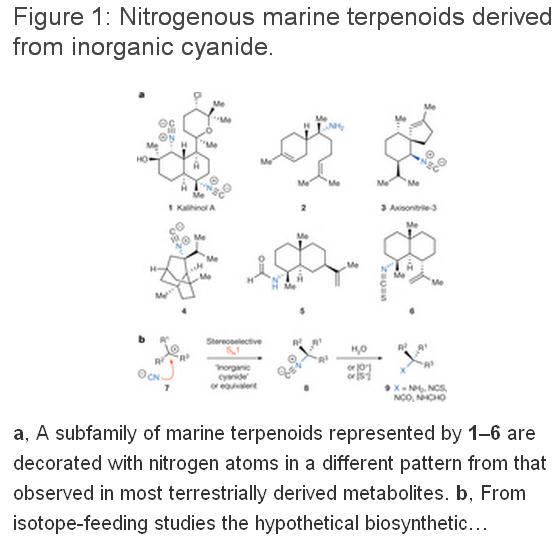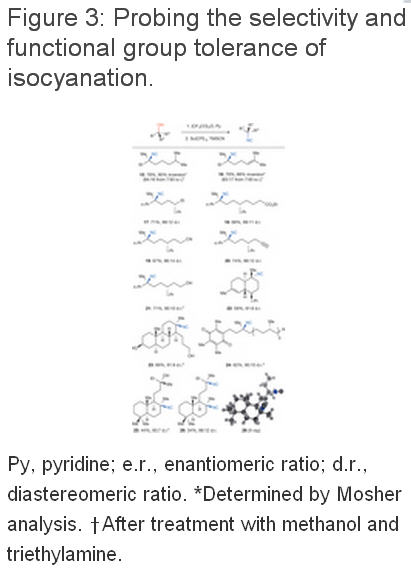博文
破解百年化学难题,改进药物合成(2013-09-13修改)
 精选
精选
|||
破解百年化学难题,改进药物合成
诸平

据2013年9月11日《科学日报》(ScienceDaily)网站报道,美国最大的私立非赢利性质的研究所——斯克利普斯研究所(Scripps Research Institute,简称TSRI)的研究人员,已经找到了一种将有机化学的基础性反应应用于一类不易得到的化学物质的合成反应的新方法,此转换一个世纪以来都被认为不可能发生的。经典的SN2反应使得化学家们创建和修饰了许多药品以及其他有用的有机分子,但是此反应一直被认为不适宜于某些化合物的合成。2013年9月12日出版的《自然》(Nature)杂志上刊登了一篇论文,描述了一种新的类似SN2(SN2-like)的反应,破解了这一难题,克服了这一限制。
TSRI的Ryan A.Shenvi助理教授,也是这篇研究论文的主要作者(senior author)谈到,他们已经扩大了对此基本技术敏感的分子范围,如现在可以采用化学合成方法制得具有良好开发前景的一组抗疟药物和抗癌化合物,这些药物在之前是不可能通过化学合成得到的。

雨伞翻转(Flipping the Umbrella)——过程类比
SN2反应可以用来分离分子的一部分,也就是被称为官能团部分,使其脱离中心碳原子,同时,另一个官能团加成到中心碳原子的对面一侧。这种结构性的翻转可以显著地改变化合物的化学性质。Ryan A. Shenvi认为,这就像把雨伞的里外翻了个身。此过程可以形象地与雨伞在大风作用下从里向外翻转的过程类比。
可以预见SN2翻转,我们称其为碳原子的立体化学。在传统上,立体翻转反应(stereoinversion reactions)是1896年德国化学家保罗·瓦尔登(Paul Walden,1863-1957)首次提出——瓦尔登翻转,即化学反应中,分子在手性中心发生的构型转换。但是瓦尔登翻转一直未被应用于已知化合物叔醇或其衍生物,在20世纪初被克里斯托弗·英戈尔德(Christopher Ingold,1893~1970)作为一个一般性问题再次提出。在这些化合物中,碳原子的兴趣是与三个其他碳原子相连接,但是其他碳原子对于其键合反应会产生有效地屏蔽作用。为了回避这个长期存在的局限性, Ryan A. Shenvi和他的研究助理Sergey V. Pronin开发出一种方法,他们采用一种特殊的酸催化剂附加一种不寻常的含氮分子即氰化物的衍生分子。此酸有助于从中心碳原子的一侧分离一种氟官能团,然后在中心碳原子的另一侧与氮形成新的化学键,从而完成立体翻转。Sergey V. Pronin说他们的基本想法就是用一种具有立体化学构型的叔醇来配置氮官能团,在离去官能团的相反位置再设置新的立体化学构型的官能团。
更少的步骤合成稀有之物
为了展示这项新技术、Sergey V. Pronin和研究生Chris Reiher将其用于构建或者修饰一组化合物,而且反应步骤相对较短,使用了廉价易得的叔醇为原料。Sergey V. Pronin举例说明他们取维生素E(生育酚)的一种衍生物,经过几步将其变成了一种他们称其为吖生育酚(aza-tocopherol)的物质,在此物质中氧原子被氮原子替换,否则其合成就不可能如此轻而易举,而是一件非常困难的事。化学家也显示了新反应可以简化被称为海生异氰萜烯(marine isocyanoterpenes)类化合物的制备,这些化合物是由海生海绵动物和其他海洋动物自然而产生的。科学研究已经发现这些化合物有抗癌、抗疟、抗真菌和其他潜在的有用属性,但科学家采用传统的合成化学方法很难对其进行人工合成。然而,使用此新技术,研究人员能够制备一些稀缺的海生异氰萜烯类化合物,而且是用来源丰富、可再生的陆生萜烯类作为原材料,合成步骤比之前曾经报道的合成步骤更短。就其自身而言,新的合成方法填补了有机化学家工具箱中的一大空白。但Ryan A. Shenvi希望尽快进一步扩展其应用,能够使类似叔醇和其它反应物之间的SN2替换反应顺利进行。研究人员认为这种反应将教给我们如何实现叔碳形成C-O、C-S甚至C-C键的立体翻转。



2013年是保罗·瓦尔登(Paul Walden)诞辰150周年纪念日,如果他在天之灵能够获悉100多年之前他首次提出的立体翻转反应(stereoinversion reactions)今天有所新突破,他一定会感到由衷的欣慰与自豪。更多信息请注意浏览原文——Sergey V. Pronin, Christopher A. Reiher, Ryan A. Shenvi. Stereoinversion of tertiary alcohols to tertiary-alkyl isonitriles and amines. Nature 501, 195–199 (12 September 2013) doi:10.1038/nature12472。
美国《化学与工程新闻》(C&EN)周刊网站2013年9月11日也有报道,转载如下:
Alcohols’ Tertiary Center Undergoes Stereoinversion
News Channels: Organic SCENE
Keywords: tertiary alcohol, tertiary alkylamine, tertiary alkylisonitrile, Lewis acid, SN2 reaction

It’s turnabout time for triply substituted alcohols in a new reaction, which flips the configuration of the alcohols’ central carbon as the compound is transformed into an isonitrile. The reaction provides a shortcut to compounds with tertiary alkylisonitriles or tertiary alkylamines that could make it easier to synthesize natural products and design new pharmaceuticals and materials.
Students of organic chemistry learn early that the SN2 reaction—in which a nucleophile displaces a leaving group in such a way that the substrate’s stereochemical arrangement is flipped—can’t take place on tertiary carbons. The triply-substituted carbon electrophile is simply too crowded for the reaction’s required backside attack.
Now chemists have come up with an SN2-like reaction that transforms tertiary alcohols into tertiary alkylisonitriles while inverting the substrate’s stereochemistry (Nature 2013, DOI: 10.1038/nature12472). Ryan A. Shenvi, Sergey V. Pronin, and Christopher A. Reiher of Scripps Research Institute, in La Jolla, Calif., developed the reaction, which makes use of the strong Lewis acid scandium(III) trifluoromethanesulfonate. The substrate alcohols are converted into trifluoro-acetate esters, which undergo attack by the nucleophile trimethylsilyl cyanide. The resulting isonitrile can be converted into many other nitrogen-containing functional groups, Shenvi noted.
The work was also presented this week at the ACS national meeting in Indianapolis in a symposium held by the Division of Organic Chemistry.
Shenvi told C&EN that he wouldn’t call the transformation an SN2 reaction because about 10% of the product retains its original stereochemical configuration. “That might indicate that the reaction doesn’t proceed through a single transition state,” he said. Rather, Shenvi suspects the reaction forms a transient ion pair that blocks the incoming nucleophile from one side of the substrate.
“The stereocontrolled synthesis of aliphatic amines remains a challenging endeavor, and Shenvi’s work not only provides an excellent solution but does so in a functional-group-tolerant manner with readily accessible reagents and intermediates,” commented John L. Wood, an expert in organic synthesis at Baylor University, in Texas. “There are certainly many methods that one can employ to access these compounds, but none that are as direct.”
Shenvi’s team is currently using the reaction to make antimalarial compounds, but he has bigger plans. “The way forward is to develop an entire arsenal of SN2-like reactions of tertiary alcohols that don’t incorporate just nitrogen” but sulfur, oxygen, and carbon as well, he said.
https://blog.sciencenet.cn/blog-212210-724269.html
上一篇:孕妇饮酒对胎儿有没有不良影响?
下一篇:出生缺陷的首例蛋白质组学分析:展示出一种新技术的力量